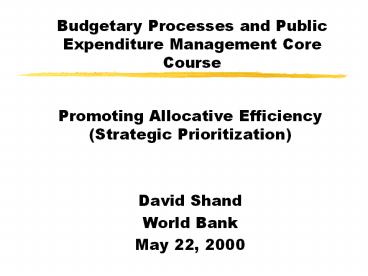Budgetary Processes and Public Expenditure Management Core Course - PowerPoint PPT Presentation
Title:
Budgetary Processes and Public Expenditure Management Core Course
Description:
Budgetary Processes and Public Expenditure Management Core Course Promoting Allocative Efficiency (Strategic Prioritization) David Shand World Bank – PowerPoint PPT presentation
Number of Views:173
Avg rating:3.0/5.0
Title: Budgetary Processes and Public Expenditure Management Core Course
1
Budgetary Processes and Public Expenditure
Management Core Course
- Promoting Allocative Efficiency (Strategic
Prioritization) - David Shand
- World Bank
- May 22, 2000
2
- Addressing the big issues of public expenditure
- Level 2 is always the hardest!
- The big issues have major political elements
- But a technocratic approach looking at
objectives, alternatives, costs and benefits can
assist in this political decision making.
3
- Principles
- Expenditures should be affordable in the medium
term, be based on government priorities and on
the effectiveness of public programs. The budget
system should create conditions and incentives
that facilitate reallocation from lesser to
higher priorities and from less to more effective
programs.
4
- Affordability,
- Expected Results
- Relative Priority
- Basic Elements
- The capacity and willingness to reallocate
- Priority-setting process in government
- Information on program outcomes and
effectiveness
5
Requirements
- Willingness to think about why we are spending
money on particular purposes and what we are
actually getting for it. - Recognition that resources are limited and that
therefore we need to think about alternatives and
opportunity cost. - Objectives to be determined or specified. But are
governments willing to be explicit? - Relevant information on costs, outputs, and
outcomes? (Is all this information useful?)
6
Requirements (contd)
- A linkage between the analysis/evaluation and the
decision-making processes - A hard medium-term budget constraint
- Ability and incentives to reallocate resources
7
Allocative Efficiency at What Level?
- Between broad objectives - economic growth,
poverty reduction, regional development - Between sectors - education versus health versus
defense - Within sectors -
- primary/secondary/tertiary/vocational
education/university education - public health/primary care/hospitals/family
planning - army/air force/navy
8
Allocative Efficiency at What Level?
- Between programs - what is a program?
- Within sub-sectors - spending on teachers,
schools or textbooks? Quality versus quantity.
9
Some Prior Questions
- Is this a function of government? Is the
activity delivering a public or a private good? - Is it aligned with government objectives?
- Or is it historical, dictated by interest groups
(client capture), result of drift, inaction and
lack of information? - Are there alternative mechanisms apart from
direct government expenditure? e.g. regulating
the private sector, providing government
guarantees.
10
Some Prior Questions (contd)
- Also a need to consider tax expenditures
- Who legitimizes organizational/program
objectives? Need for cabinet/ ministerial
involvement? - New Zealand 2010. Attempting to link strategic
and operational objectives (SRAs and KRAs)
11
Some Examples of Major Expenditure
re-allocations?
- Achieving quality fiscal adjustment
- Reductions in civil service number and/or cost,
wage and/or recruitment freezes - Streamlining of the public service (technical
efficiency) - Across the board cuts in administrative costs
- Procurement reforms
- Reform/reduction in cost of public enterprises
- Reductions in transfers to sub-national
governments
12
Some Examples of Major Expenditure
re-allocations? (contd)
- Reductions in capital works (which ones?)
- Reduction or abolition of subsidy/assistance
programs to industry, agriculture etc. - Redesign or re-targeting of social transfer
programs - particularly public pension reforms - Reductions in defense expenditure
- To what extent are such reallocations based on
any systematic consideration of priorities?
13
Problems in Strategic Prioritization
- Lack of linkage between the plan and the budget -
promise in the plan what you cant deliver in
the budget - Investment led priorities, rather that program
priorities - Donor driven priorities
- Priorities determined by other levels of
government - Protected enclaves of government spending
14
Mechanisms which Promote Strategic Prioritization
- Aggregate medium-term fiscal targets
- Hard budget constraint - no add ons without
corresponding reductions - Consideration of alternative mechanisms - does
this have to involve public expenditure? - Sectoral strategies (strategic plans?) - costed
over the medium-term
15
Mechanisms which Promote Strategic Prioritization
(contd)
- A medium-term expenditure framework (MTEF)
- Arena within which policies compete and
coordinate - cabinet, budget office and
ministries internal budget preparation
processes focus on strategic matters, not process
or details.
16
Mechanisms which Promote Strategic Prioritization
(contd)
- Ex-ante and ex-post evaluation
- Creating capacity and willingness to reprioritize
and reallocate - Spending ministries having greater ownership of
their budget - Encouraging ministers/ministries to reprioritize
within budget envelopes































